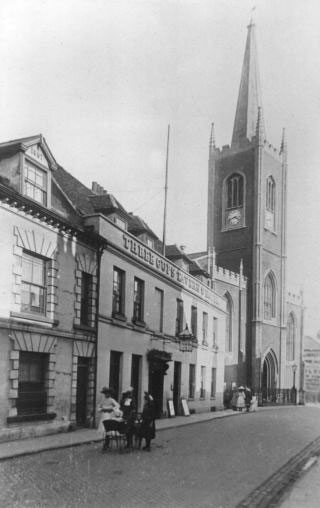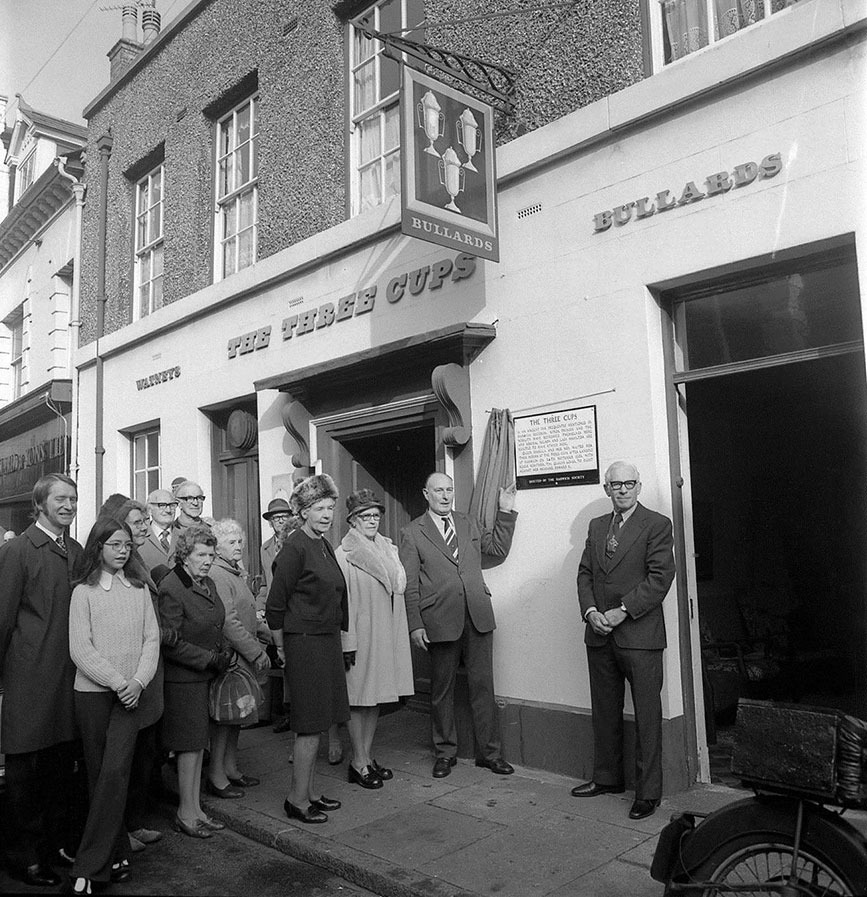The Three Cups
| Status: | Closed. Now a private residence with no public access. Please respect the owners' privacy when viewing the exterior of this building. |
Occupying a prominent position next to the church the Three Cups is an ancient hostelry with a rich history. It closed in 1995 and is now a private house.

History
The Three Cups is the stuff of Harwich legend and has traded as a public house, hotel, livery stables and inn for a very long time, seeing many famous people come and go. It is a private residence today but proudly displays a plaque to remind residents and vistors of its place in history.
It is sometimes difficult to trace the history of a building in a busy town – even if you know roughly when it was built – because record-keeping never managed to keep pace with the need for change. What we do know is that the building we call the Three Cups today was built circa 1500 and it was probably a purpose-built inn.
Going back beyond that date is difficult; there has always been a claim that Queen Isabella came to the Three Cups in 1326 on her way to depose her estranged husband, Edward II but original documents from the time seem to suggest that she landed further north and was provided with horses by her supporters rather than a Harwich innkeeper.
The building we see today is timber framed but you would hardly know that from the road as the visible elevations have been bricked up and the front rendered to form the impressive Georgian facade. This large frontage to Church Street comprises a 7-window range of sash windows and a central early 19th Century doorcase with moulded architrave and console brackets supporting a dentilled cornice.
The end of the property on the church side shows off the red Flemish-bond brickwork of the period but the whole building is missing its former upper story which was removed in 1949 following a fire.
In 1711 we do know that Sir James Thornhill, the eminent baroque artist responsible for the paintings on the inside of the dome of St Paul's Cathedral, was at the Three Cups because he starts his diary entry for Sunday 3rd June with “Dined at ye 3 Cupps”.
In 1715 the Three Cups was part of the estate of the late William Kempster and the subject of some controversy as the rental proceeds of the estate were supposed to pay for the education of William's youngest son Thomas until age 21. It seems that Thomas didn't think this was the case and issued a bill of complaint against his elder brother and sister who had to prove that they had upheld the will. The rent for the Three Cups was “about £50 originally, but now reduced to £30” and was collected by Thomas's sister Sarah Pybus and her husband Bryan.
In December 1728 Frederick Prince of Wales (the eldest son of King George II) stayed about an hour at the Three Cups on his way to Colchester and London. With all those connections within the House of Hanover Harwich was well-placed as a stopover for Royal commuters.

In November 1734 the Princess of Orange (Anne, Princess Royal of England, the eldest daughter of King George II of England and married to William VI, Prince of Orange) was forced to spend several days in Harwich because there was insufficient wind for her to sail back to Holland. Accounts suggest that she much endeared herself to the people of Harwich during that time and laid on a magnificent dinner of fifty dishes at the Three Cups at which the Mayor, Aldermen and other members of the Corporation of Harwich were entertained. It was also reported that when she decided to go for a walk in the countryside around Harwich all the stiles were removed all the paths levelled.
In 1751 the owner of the Three Cups was Thomas Hallstead who built salt water baths nearby and advertised in the Ipswich Journal inviting people to stay at his inn and take the seawater cure at his new baths. By 1760, however, Thomas Cobbold, who owned the brewery on the waterfront and a good many inns had gone into competition with Hallstead and not only taken over his baths but also the Three Cups.
In 1823 the Three Cups found itself in the stewardship of the Bull family and there it remained for 63 years passing from William to Anne to Joseph to John.
in September 1843 a group of yacht owners held their Regatta Dinner at the Three Cups determined to form an east coast yacht club. This was initially called the Eastern Yacht Club. The first Commodore was TM Gibson MP, owner of a 30 ton yawl “Claude” and a member of the Royal Yacht Squadron. The Eastern Yacht Club later became the Royal Harwich Yacht Club.
On 15th August 1854 the very first passenger train arrived in Harwich. After much uncertainty and land speculation over the coming of the railway this momentous event was marked with a public dinner at the Three Cups.
The Three Cups was listed Grade II by English Heritage in 1972.
Notable Facts, Things to Look Out For
- There has long been a claim that Lord Nelson came to the pub to meet his lover Lady Hamilton but there is no documentary evidence. Some insist that Nelson would have stayed aboard his boat the Medusa which was moored in the harbour during his time in Harwich but others have pointed out that if he was to come ashore for a tryst it probably wouldn't be recorded. We'll probably never know the truth.
